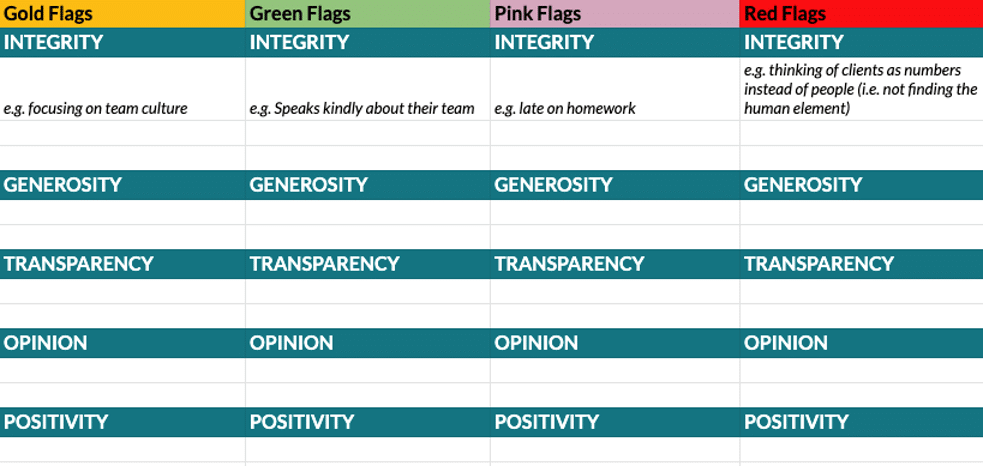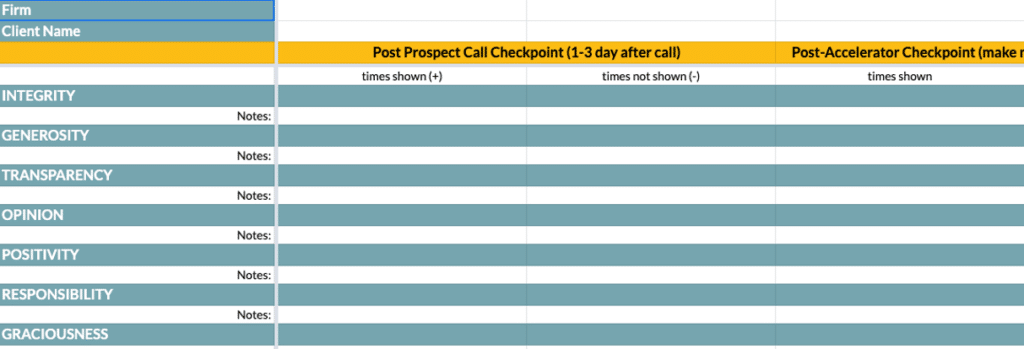
You CAN choose who you work with. Whether you’re just starting out or you’re an established firm, many of us feel like we need to take on every prospect who walks through our door. You can be selective about who you take on as clients. And you need to be.
If you don’t, you’ll end up working with people who aren’t a values match and who don’t follow your processes and systems. Your valuable time will be filled with time consuming work – chasing paperwork, following up late payments, explaining why you do things a certain way – leaving little time to work on the business and with the very best clients for you.
Whilst you may feel like you’ve been pretty good at only working with people who match your values, every now and then, you may accept a client who isn’t the right values match. And that’s okay. It doesn’t mean the client isn’t a nice person or they’ve done anything wrong. It could mean:
- you don’t share the same values
- you don’t have the same focus or intentions
- they’re not ready for what you have to offer
- you don’t offer/you don’t enjoy doing the services they need most
Making mistakes about who you decide to work with is how you learn and how you know your processes need strengthening.
Make sure all the clients you work with are a great match to you, and you’re the best accountant for them, by building your client acceptance process.
How will a client acceptance process help me and my team?
A client acceptance process is something you and your team can follow in order to work out if a client is the right fit for your business or not and whether it’s a good idea to take them on as a client. When you use a client acceptance process:
1. You won’t take on clients who you later need to fire because they aren’t a good fit. The process of firing clients can be mentally and emotionally exhausting for you and the team and uses up valuable resources within your firm (time, energy, money).
2. You take away any risk of clients leaving early on in the process because they realise they aren’t a fit. You want to build a relationship with your clients and help them be as invested in the partnership as you are.
3. It will save you the mental and financial strain taking on clients who aren’t a fit can cause you. These clients end up taking more time because:
- you need to follow-up with them multiple times to submit something you need
- you have to convince them to follow your process and do things a certain way
- you have to spend time explaining every detail of the work you’re doing for them, as they need to know exactly where all their money is being spent
- You have to educate them about things they need to already understand.
4. You need to be very clear on your values and your brand, which helps make marketing to the best clients easier for you.
5. Your team gets to work with people they love and who they’ll do better work for. When you only have clients who are a good fit for your firm, your team will be happier and more productive and your systems and processes will work smoothly and efficiently.
Your values are critical to deciding who to work with
Your values describe who you are and what’s important to you. Myonlinetherapy.com says “Values help us live with direction and purpose – like a guiding compass. Whatever is going on in our lives, our values can show us a path forward, and help us make better choices.”
Values aren’t just something you stick on your wall in your office. You need to live them out. “If you don’t know what your values are, you can’t make good decisions. You’ll just decide based on how you feel at the time.” – Karen Reyburn.
If you’re feeling low and heavy when speaking to a new prospect, you may be too distracted to decide if they are an ideal client or not. If you are having the best day, you might be overly generous and overlook a few pink or red flags because they are a nice person. Side note: If you ever hear yourself saying “They’re a nice person, but…”, there’s your flag right there.
Those who you work best with will be a values match. They may also have different personal or business values to you but the values you hold will be meaningful to them as well.
If you haven’t got values yet or aren’t sure if they truly match who you are as a firm, you can do a values session with your team.
Create a potential flags list according to your values
A flag is something that catches your attention during conversations with someone. It highlights ways in which someone may be a match with your firm, or not. We all know red flags mean danger but in order to measure if someone is a fit or not, we can’t just notice the red flags. We also need to look out for good flags or not-so-sure flags. For this reason, we developed gold flags, green flags and pink flags as measurement tools for our PF client acceptance process.
Gold flags – prospects we definitely want to work with because they match our values in every way and think of us as part of their team. Gold flags are for “…those people who say or do something so amazing, or there are so many green flags waving you want to start working with them instantly because it’s so enjoyable, they’re so creative and curious, and you feel rejuvenated just having the conversation”.
Green flags – prospects we probably want to work with because they match our values and are excited about marketing.
Pink flags – prospects who don’t match all of our values but could be a better fit with some marketing education and clear communication. Pink flags are not as bad as red flags and measured alone, they aren’t dangerous. But a group of pink flags could indicate the prospect is leaning towards red flag status.
Red flags – prospects we don’t want to work with because we aren’t a good fit and they don’t match our values and who we aren’t able to do our best work for.
How to create your potential flags list:
1. Meet with your client-facing team to discuss the different types of flags. Encourage them to draw on their own experiences of working with clients who didn’t work out. What went wrong? What flags did you miss? What patterns were there now you’re looking back?
2. Create a gsheet with 4 columns: gold flags, green flags, pink flags and red flags.

3. Add your values under each flag type. These need to be clearly defined before creating your client acceptance process so you can make good decisions.
4. List different types of flags underneath each value under the particular flag. These will be emotions, responses or actions the client shows during your interaction with them. The interaction can be from events they attend with you, emails or messages they send to you, conversations during a meeting or prospect call, and how they follow your processes or way.
5. Get the full team to review the sheet to see what you might have missed.
Identify checkpoints in the sales process to measure the prospect against your values
Once you have created your potential flags list, identify all the checkpoints critical to determining if you want to work with this client or not. This could be long term or short term. For example, you might want to have your first checkpoint after receiving an initial diagnostic. Your second checkpoint could be after the prospect call. The third could be after doing a small project with the client.
To identify which checkpoints will work best for your firm, you need to have a solid sales process. Think about all the contact points you have along the way and determine which ones give you the information you need to make an informed decision about the client.
Develop a client qualifying gsheet to track flags throughout the process
The client qualifying gsheet is what you will use to track the flags your prospects display throughout your interactions with them. This can also be used for clients you’ve already taken on.
1. Create a master gsheet and in column A, list your identified values.
2. In the other columns, list the checkpoints you identified in the step above.
3. Create a section to list times the prospect showed the potential flag and times these were not shown.

4. Identify when to complete the sheet. For example, at the first step in the sales process, we’ve made a note to complete the sheet 1-3 days after the prospect call so it’s still fresh.
5. Create different tabs within the gsheet for each new prospect you review so it’s all in one place.
Once you have the sheet and the process set up, share it with your team and encourage them to use it for each new prospect. Explain how having this process will help filter out those who aren’t a good fit so your team gets to only work with the very best clients for them.
Once the sheet has been filled in for each new prospect and/or existing client, you and your team can evaluate in the following way:
- If you can only think of times the prospect didn’t show the values, they aren’t a fit.
- If the prospect has more times not shown than shown, this would indicate that they aren’t a fit either.
- If the prospect has more times shown but still has plenty of times not shown, you need to review this carefully and see how many of the ‘not shown’ are red flags. If the majority of these are red flags, this indicates they aren’t a fit.
- If you can only think of time the prospect showed the values or you have very little ‘not shown’, they appear to be a good fit.
Although you have the data, the decision to work with this prospect or not doesn’t need to rely only on you. Involve your team in your decision too. Discuss it during team meetings, send the team a video with the results and your thoughts and vote on it if needed.
Keep reviewing your client acceptance process – it’s ever changing
As your business grows and shifts, you need to continue to review your client acceptance process. This process is a continual work in progress and won’t be set in stone. As you work with new prospects, you’ll pick up new potential flags. Add these to the flags list and continue building it. As your sales process is perfected, you might find you have additional checkpoints to add to your client qualifying sheet.
You can choose who you work with. Following a client acceptance process means you aren’t just reacting by emotion or gut feel, but rather making informed decisions about who you want to work with based on the data. It’s easier to say no to prospects when the data shows they aren’t the best fit.
Your prospects will benefit from this process. If they are a fit, they’ll appreciate being with the right firm, getting the best service and building a partnership with someone who has the same values and is focused on the same or similar goals. Those who aren’t a fit will be grateful you chose not to work with them even if they may not recognise it straight away.
Your team will thank you because it means they are working with the very best clients for your firm. The ones who listen, follow the way, submit things on time and those they truly enjoy working with.
If you’re wondering whether all your clients are a fit or you’re struggling to find the right clients for you, connect with the PF team by filling out this diagnostic. We’ll help with your marketing so it only brings you the very best clients for you.

